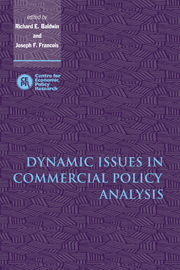Book contents
- Frontmatter
- Contents
- List of figures
- List of tables
- Preface
- List of conference participants
- 1 Introduction
- 2 Transition dynamics and trade policy reform in developing countries
- 3 Putting growth effects in computable equilibrium trade models
- 4 Innovation, capital accumulation, and economic transition
- 5 Multinational production, skilled labour, and real wages
- 6 Economic policy and the manufacturing base: hysteresis in location
- 7 Trade liberalization and investment in a multilateral framework
- 8 Investment creation and investment diversion: simulation analysis of the Single Market programme
- 9 Blueprints, spillovers, and the dynamic gains from trade liberalization in a small open economy
- 10 Trade policy and North–South migration
- 11 Long-term modelling of trade and environmental linkages
- 12 Labour markets and dynamic comparative advantage
- Index
1 - Introduction
Published online by Cambridge University Press: 13 January 2010
- Frontmatter
- Contents
- List of figures
- List of tables
- Preface
- List of conference participants
- 1 Introduction
- 2 Transition dynamics and trade policy reform in developing countries
- 3 Putting growth effects in computable equilibrium trade models
- 4 Innovation, capital accumulation, and economic transition
- 5 Multinational production, skilled labour, and real wages
- 6 Economic policy and the manufacturing base: hysteresis in location
- 7 Trade liberalization and investment in a multilateral framework
- 8 Investment creation and investment diversion: simulation analysis of the Single Market programme
- 9 Blueprints, spillovers, and the dynamic gains from trade liberalization in a small open economy
- 10 Trade policy and North–South migration
- 11 Long-term modelling of trade and environmental linkages
- 12 Labour markets and dynamic comparative advantage
- Index
Summary
Economic processes are dynamic. Human, physical, and knowledge capital stocks change over time, as do natural resources stocks. People and capital migrate, populations grow, and investment rates change. Although these assertions are self-evident, most applied commercial policy analysis ignores them. For the simple reason that dynamic processes are difficult to capture formally, most applied analysts work with static models. This is an important shortcoming because commercial policies can have dynamic effects and the presence of time-varying factor stocks, technologies, etc. can affect the way in which we evaluate commercial policy. Moreover, trade theory now offers rigorous, formal treatment of many dynamic issues, including interactions between, on the one hand, commercial policy and, on the other hand, the endogeneity of factor endowments (location and size of stocks), natural resource depletion, and the evolution of the technology and skills base.
This volume brings together the work of research economists who are developing and refining methods and models that allow quantification of dynamic effects in applied computation models. The overall objective of the volume is to extend the basic conceptual underpinnings of applied commercial policy analysis in the direction of dynamic issues and applications. Our immediate objective in this introductory chapter is more modest. In this chapter, we offer our own brief tour of major issues related to the extension of applied trade models to address dynamics issues better. In the process of this tour, we provide an overview of the chapters in the volume, placing them within our own characterization of the broader thematic context.
- Type
- Chapter
- Information
- Dynamic Issues in Commercial Policy Analysis , pp. 1 - 13Publisher: Cambridge University PressPrint publication year: 1999



